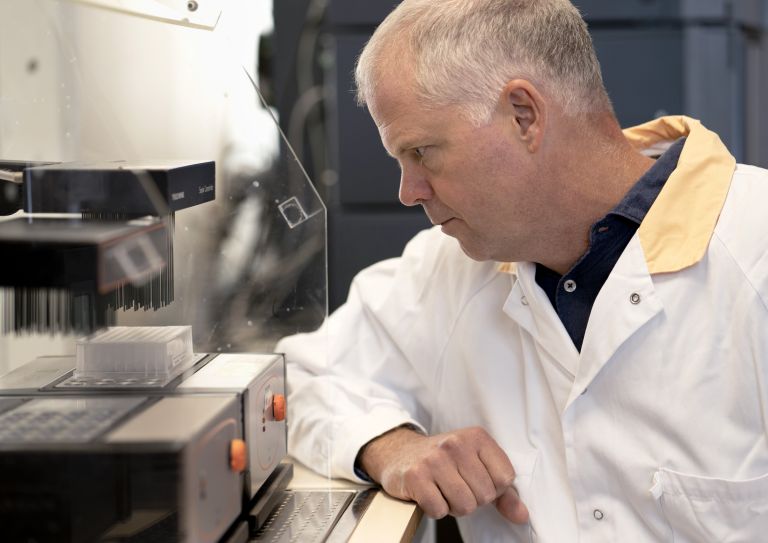
Fredrik Bäckhed
Professor of Molecular Biology
Wallenberg Scholar
Institution:
University of Gothenburg
Research field:
How gut microbiota impacts cardiometabolic diseases


Wallenberg Scholar
Institution:
University of Gothenburg
Research field:
How gut microbiota impacts cardiometabolic diseases
They are numerous, interact constantly with their surroundings and can both flourish and suffer alongside their neighbors. They are also hugely important to our wellbeing. Together, they make up our gut microbiota – the complex and essential assemblage of bacteria in our intestines.
Bäckhed, who is professor of molecular medicine at the University of Gothenburg, has spent more than twenty years exploring how gut microbiota impacts our body when we are well and when we are not. Among other things, his research team has demonstrated a link between microbiota and cardiometabolic diseases (CMDs), such as type 2 diabetes and cardiovascular disease.
Over the next few years Bäckhed will be taking further important steps to aid our understanding of human gut microbiota. His earlier research focused on changes in gut microbiota as a result of disease, but now the main question he faces is not how, but why, these changes occur.
I truly believe we can gain new insights into improving human health with the help of gut microbiota
“We need to understand the ecosystem and functions of gut microbiota in a healthy system and in a less healthy one. What drives the changes that interact with various diseases? When we know this, we will know when a system risks collapsing, what we can do about it, and how we can recreate a healthy ecosystem in the intestines again,” he explains.
In patients with CMDs the diversity of gut microbiota has diminished, with fewer oxygen-sensitive bacteria and more oxygen-tolerant bacteria. The altered composition contributes to a more oxidative environment, with an excess of free electrons. One consequence is that the composition and function of the microbiota is altered by increased expression of enzymes that can remove electrons in a process that may produce disease-contributing metabolites.
“If we can learn more about these mechanisms, then hopefully we’ll be able to control events, perhaps by blocking or changing enzyme function, or by reducing the number of free electrons,” he says.
Bäckhed’s hypothesis is that increased levels of oxygen create an oxidative environment and production of diabetes-promoting electrons. This is one of several theories that the researchers will be testing in various experiments. This is possible thanks to the know-how, technology and methods developed by the team over the years.
“Research requires a long-term approach. Funding from Knut and Alice Wallenberg Foundation enables us to ask the really difficult questions and address them over an extended period,” says Bäckhed.
The gut microbiota of CMD patients resembles that of children, whose microbiota is not yet developed, where the environment is very rich in oxygen. As a child grows, more and more bacteria become established in the intestines and the environment becomes more anaerobic – just as in a healthy adult.
The researchers hope to use their knowledge of gut microbiota development in children to work out a way of counteracting and reversing negative microbiota development in CMD patients.
“When this project has been completed we hope to be able to explain why gut microbiota changes in conjunction with cardiometabolic diseases, thereby paving the way for new therapies. It’s an ambitious goal, but I really believe we can gain new insights into improving human health with the help of gut microbiota,” says Bäckhed.
Bäckhed has always had a keen interest in science. As a child, his most frequent question was “why?” A high school teacher encouraged him in his thirst for knowledge, and he became the first person in his family to go to university. His first encounter with microbiology engendered a fascination for the very smallest organisms, which led him to molecular medicine.
“The interaction between organisms, and the fact we can test that interaction in various ways is really cool,” he says.
“The third mission” of research, which refers to outreach, is dear to Bäckhed’s heart. He has talked about his research on radio and TV, and collaborates with schools, the International Science Festival, and the Universeum science center in Gothenburg.
“We researchers have a duty to reach out with fact-based knowledge to the general public. So many untruths circulate, especially in my field, and it’s important to refute them,” he says.
Over the years his research has garnered a great deal of attention and been published in highly-ranked scientific journals. Bäckhed highlights good collaboration in the research team as a recipe for success, combined with stubbornness and not being afraid to fail.
“Many of our successes have been born out of failure; when things don’t go as expected, we can make new discoveries. I also believe the environment and morale of the team are critical if we are to have good discussions. We’re like a family – we present a united front to the outside world, but if something isn’t right, we must be able to give constructive criticism,” he says.
Text Ulrika Ernström
Translation Maxwell Arding
Photo Johan Wingborg